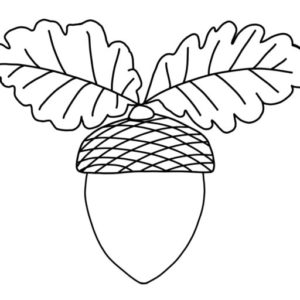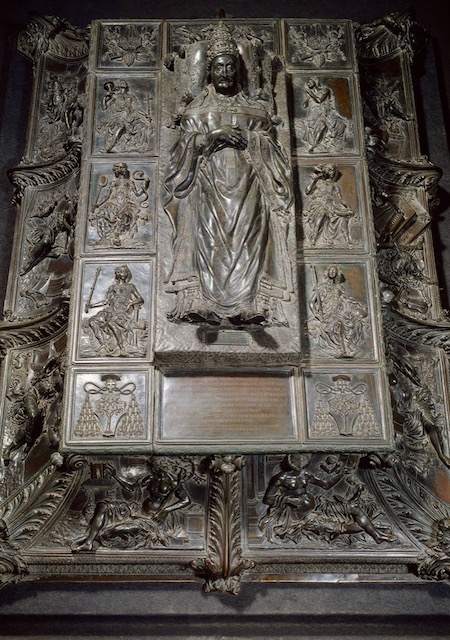Innovative Representations of the Liberal Arts: Pollaiuolo’s Tomb of Pope Sixtus IV
The main series of images on which this capstone will focus is Pollaiuolo’s Tomb of Pope Sixtus IV, c. 1484-1493, (figure 4). Painter, goldsmith, and draftsman, Antonio Pollaiuolo, who often worked with his brother Piero Pollaiuolo, created this monumental freestanding bronze tomb, adapting his skills from smaller scale metalworking to working in cast bronze on a large scale. Commissioned by Giuliano della Rovere and likely designed in conjunction with an intellectual advisor, the bronze tomb features a life-size effigy of the Pope raised on top, with seven panels depicting images of the Theological and Cardinal Virtues placed around his body facing up on the flat top surface. Ten images of the Liberal Arts, together with Prospectiva, Theology, and Philosophy, are shown in high relief on the angled border down to the pedestal base with each panel separated by acanthus leaves. Of the virtues, Charity is placed near the pope’s head with Hope, Temperance, Justice on the right side, and Faith, Prudence, and Fortitude on the left side (see figure 5 for a diagram). An inscription near the pope’s feet highlights Sixtus’s illustrious career as Pope and his accomplishments within the papacy, emphasizing his military victories alongside his mastery over the philosophical and theological writings of the time through the expansion of the Vatican Library under his patronage.[18] On the corners of the top tier are the Arms of Sixtus in the top left and right corner, while the bottom corners are inscribed with the Arms of Giuliano della Rovere, Sixtus’s nephew and patron of the tomb. Based on stylistic variations, it seems that the effigy was created first, since a death mask was likely used to create the likeness of the face, followed by the Virtues, and finally the panels of the Liberal Arts served to complete the tomb.[19]
On the sloped, lower sides of the tomb, Pollaiuolo depicted ten female figures, seven of which represent the traditional disciplines of the Liberal Arts, with their respective attributes. Starting at the bottom, toward the feet of the pope, Rhetorica and Grammatica are depicted with echoing poses, as if reflected across their dividing ornamented barrier. Continuing up the left side, Dialectica is placed closer to Rhetorica on the bottom left, completing the Arts of the Trivium. Above her is Astrologia and Arithmetica with Astrology in the center. On the right side, Prospectiva is at the bottom, followed by Musica and Geometria. In conjunction with Astrologia and Arithmetica, Geometria and Musica complete the traditional four disciplines of the Quadrivium. At the head are Philosophia and Theologia which would have faced the altar wall in the original setting of this tomb: the chapel built by Sixtus IV for liturgical functions in Old St Peter’s, the Cappella del Coro.
While earlier, and more traditional representations of the Liberal Arts depicted a prominent individual from the respective discipline within the scene, Pollaiuolo departed from this tradition. Instead, he alluded to scholars associated with each discipline through inscriptions or objects depicted on each panel. As such, it required a learned individual to decipher each element and identify the scholar to the discipline shown on the tomb. Although the iconography and function of the tomb have been examined by scholars such as Leopold Ettlinger and Alison Wright, its critical divergences from conventional iconography of the Liberal Arts have been less analyzed. Thus, I will examine the ways in which the figures of the Liberal Arts were influenced by more than just Capella’s writing. Considering the afterlife of the Liberal Arts in subsequent depictions, I will relate each discipline to the bridge between Scholasticism and Humanism as established in Sixtus IV and Giuliano/Julius II’s own scholarship. This overlap between Humanistic and Scholastic scholarship enables an analysis of this tomb’s iconographic message concerning the broader harmony between the Aristotelian and Platonic thought.


